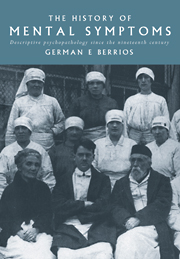Book contents
- Frontmatter
- Contents
- PREFACE
- ACKNOWLEDGEMENTS
- INTRODUCTION
- PART I The object of inquiry
- PART II Cognition and consciousness
- PART III Mood and emotions
- PART IV Volition and action
- CHAPTER 14 The will and its disorders
- CHAPTER 15 Feelings of fatigue
- CHAPTER 16 Catalepsy, catatonia and stupor
- CHAPTER 17 Tremor, rigidity, akathisia, and stereotypy
- PART V Miscellany
- REFERENCES
- NAME INDEX
- SUBJECT INDEX
CHAPTER 17 - Tremor, rigidity, akathisia, and stereotypy
from PART IV - Volition and action
Published online by Cambridge University Press: 08 January 2010
- Frontmatter
- Contents
- PREFACE
- ACKNOWLEDGEMENTS
- INTRODUCTION
- PART I The object of inquiry
- PART II Cognition and consciousness
- PART III Mood and emotions
- PART IV Volition and action
- CHAPTER 14 The will and its disorders
- CHAPTER 15 Feelings of fatigue
- CHAPTER 16 Catalepsy, catatonia and stupor
- CHAPTER 17 Tremor, rigidity, akathisia, and stereotypy
- PART V Miscellany
- REFERENCES
- NAME INDEX
- SUBJECT INDEX
Summary
Whilst stupor is the paradigm case for the motility disorders, parkinsonism represents the best example of symptomatology of the basal ganglia. This section explores its history both in its relationship to Parkinson's disease (PD) and to other clinical situations. The view that PD is but a collection of disorders variously sharing features such as tremor, rigidity, akinesia, and dysautonomy is becoming fashionable. Since the last century, this syndrome or ‘construct’ has been called parkinsonism and is now known to result from damage to pigmented cells in the substantia nigra and sympathetic ganglia. When the cause is unknown the syndrome is called Idiopathic' or Parkinson's disease proper; however, there is no evidence that this group - defined by exclusion - is homogeneous. It could be said that PD is a prototypical construct kept alive by alternatively defining it on the basis of clinical presentation or neuropathological marker (Lewy bodies). Unfortunately, the two definitions do not match: some with the symptoms do not have Lewy bodies, many with the latter do not have the disease.
This makes PD into an interesting historical subject as it offers the possibility of separately studying the history of terms (Parkinson's disease, paralysis agitans, etc), behaviours (tremor, akinesia, rigidity), and concepts and hypotheses. It also offers an opportunity to understand the way in which during the nineteenth century diseases were taken over by medical specialisms. This is the case with PD which, in spite of its clear psychiatric component, has been firmly kept within neurology. Indeed, to maintain the status quo, such component was for a long time either denied or played down.
- Type
- Chapter
- Information
- The History of Mental SymptomsDescriptive Psychopathology since the Nineteenth Century, pp. 397 - 416Publisher: Cambridge University PressPrint publication year: 1996



